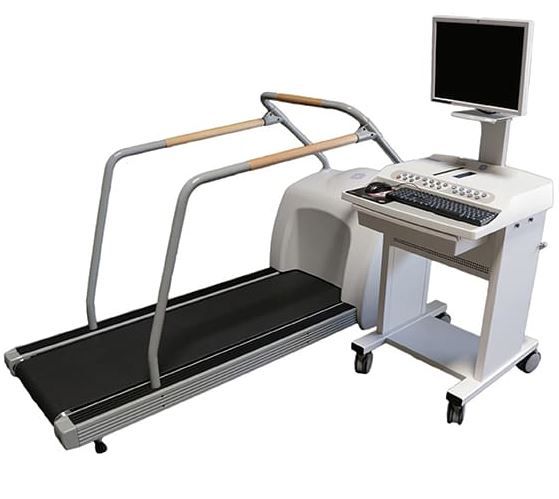Case, GE Stress System XP & T2100 Treadmill
AMERICA North (USA-Canada-Mexico)
Refurbished Ge Case Stress System
The GE Case Stress System:
ECG Analysis Frequency: 500 Hz
ST Measurements: ST amplitudes, slope, integral, index, ST/HR slope, ST/HR loops, ST/HR index up to 15 leads
E, J and Post-J Point: Manual or computer selected
Signal Processing: Incremental median updating technique
Baseline Correction: Finite Residual Filter (FRF) and/or Cubic Spline analysis
QRS Detection and Analysis: Automatic or manual lead selection
ECG Output: Real-time ECG/QRS beep/TTL synchronization output
Heart Rate: Automatic arrhythmia detection, documentation and annotation
Full-Disclosure ECG: Beat-to-beat ECG storage & event review
Reanalysis: Post-test medians measurements from E, J and post-J point selections
ECG Interpretation (Optional): Marquette* 12SL* resting ECG analysis program for adults and pediatrics
Additional ECG Function: XTI stress interpretation; Vectorcardiography (15 lead)
GE Case Data Aquisition:
Technology: Active, “Type BF” floating isolated powered 14-channel acquisition module with built-in lead-fail detection and lead prep impedance measurement
Sampling Rate: Over-sampling @ 4000 Hz
Dynamic Range: 320 mV, ± 10 mV signal superimposed on ± 150 mV DC offset
Resolution: 4.88 μV/LSB @ 500 Hz
Noise: < 15 μV peak-to-peak noise over 0.01 to 150 Hz (-3 dB) bandwidth • Frequency
Response: 3 dB, display and writer
High-Pass Filter: 0.01 (or 0.05 Hz, special use) with DC offset control
Low-Pass Filter: 20, 40, 100, 150 Hz (selectable)
Line Filter: 50.0 or 60.0 Hz notch filter (selectable)
Baseline Correction: Cubic Spline algorithm
Artifact/Baseline Correction: Finite Residual Filter (FRF) analysis
Common Mode Rejection: > 140 dB (123 dB with AC filter disabled)
Input Impedance: > 10 M Ohms @ 10 Hz, defibrillator protected
Patient Leakage: < 10 μA
Pace Detect: Orthogonal LA, LL and V6; 750 μV @ 50 μs Communications/Storage
Options:
MUSE* systems compatible via diskette; network (optional)
MUSE Web compatible for retrieval view and printing of MUSE system data
Local storage: Minimum 40 GB hard drive storage of complete ECG record and test results
PDF export of final reports with auto naming protocols also from Microsoft® Word and Excel
XML export of specified data
CASE* network server with editing workstations
Windows® XP operating system Display:
Display Type: LCD (flat panel display)
Display Resolution (Minimum): LCD-1280 x 1024
Display Size: 17 or 19-inch LCD
Monitored Leads: 3, 6, 12 or 15
Displayed Leads: Number on screen 3, 6, 12 or 15
Display Format:
3 rhythm
3 rhythm + medians
3 rhythm + trends
6 rhythm
4 x 2.5 + 1 rhythm
2 x 6 • Display Speeds 25
50 mm/s
Display Sensitivity/Gain: 2.5, 5, 10, 20 mm/mV
Displayed vital Signs Data (Configurable):
Heart rate, target heart rate, blood pressure, exercise clock, stage clock,
phase clock, protocol, speed, grade, Watts, METS, RRP and SpO2
Displayed data ST scan/median complexes, arrhythmias,
ventricular ectopic/min counter, 3 to 12 lead waveforms, lead check torso and 12 leads,
waterfall display, trends, tabular summary, stored ECG strips, interpretation,
time-of-day clock, patient name, warning messages and prompts
Writer:
Writer Technology: “Instant” load, thermal dot array
Writer Leads: 3, 6, 12 or 15 leads (standard, NEHB, Cabrera, configurable)
Writer Speeds: 5, 12.5, 25 and 50 mm/sec (± 2%)
Writer Sensitivity/Gain: 2.5, 5, 10 or 20 mm/mV (± 5%)
Writer Resolution: Horizontal 1000 lines/sec x 200 dpi dedicated local printing. 200 x 200 dpi generic printing
Paper Type: Thermal, perforated, fan-fold, 300 sheets/pack
Paper Size: A size 214.63 x 280 mm (8.45 x 11 in); A4 size 210 x 297.5 mm (8.27 x 11.0 in)
Physical Specifications:
Height: 148 cm (58 in) with no monitor installed
Width: 62 cm (24 in) with paper tray removed
Depth: 75 cm (30 in)
Weight 68 kg (150 lb) without monitor
Minimum Server Requirements:
Microprocessor: Pentium® ! 1.6 GHz
RAM: 256 MB
Hard Drive: > 40 GB
Operating system: Windows 2000 Server; Windows 2003 Server
GE CASE stress system Interfaces Included:
Acquisition module
Keyboard (PS/2) anti dedicated stress keypad (USB)
Mouse (PS/2)
Built-in thermal printer (USB)
100 Mbps Ethernet MUSE compatible
6 serial ports: (COM 1-2, COM A-D) treadmill, BP, ergometer, SpO2
4 analog and 1 TTL (trigger) output analog ergometer, camera sync, etc.
Diskette drive: 3 1/2 in, 1.44 MB
PC-compatible for data storage
CD-R/W drive: readable for software updates; archivable data optional
GE CASE stress system Electrical Power:
Power Supply: AC operation only
Operating voltage range 100-120 VAC, 50-60 Hz, 2.8 A; 200-240 VAC, 50-60 Hz, 1.4 A
Power consumption 350 W max (1200 BTU/hr); < 250 W normal (850 BTU/hr); < 30 W tandby (100 BTU/hr)
GE Case Operating Conditions:
Temperature: +10 to 40°C (+50 to 104°F)
Humidity: 20 to 95% RH non-condensing
GE CASE stress system Storage/Transport Conditions:
Temperature -40 to +70°C (-40 to 158°F); Paper discoloration may occur at high temperatures
Humidity: 15 to 95% RH non-condensing

